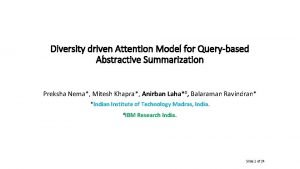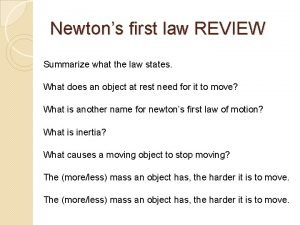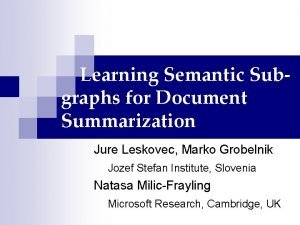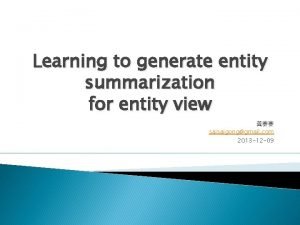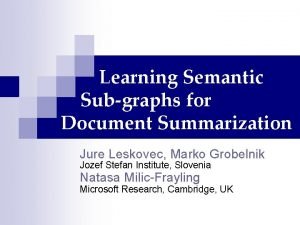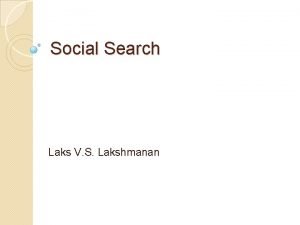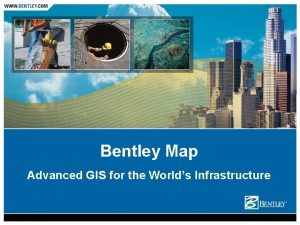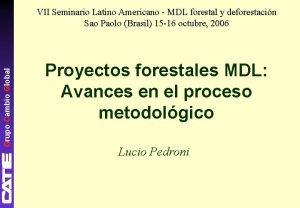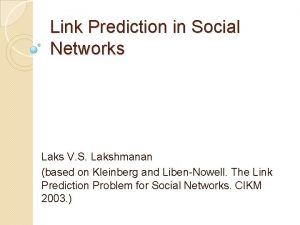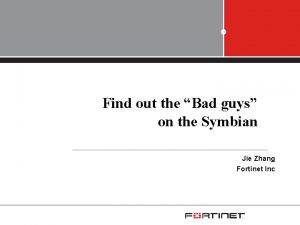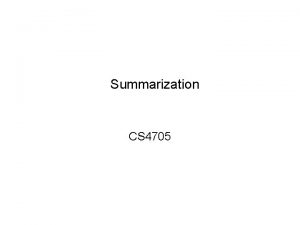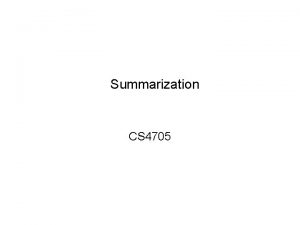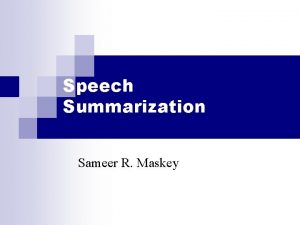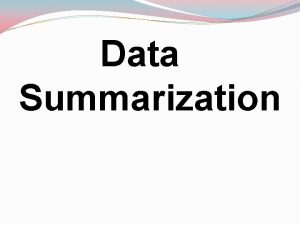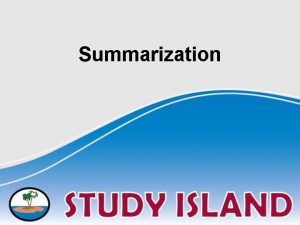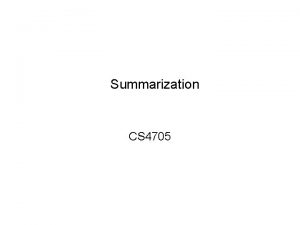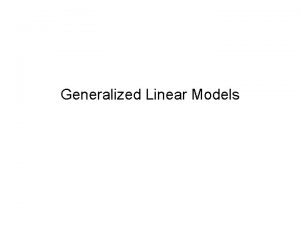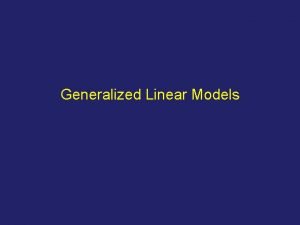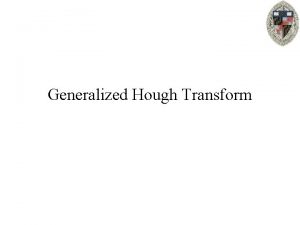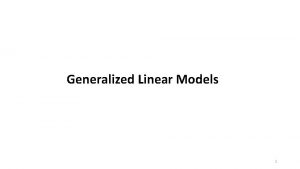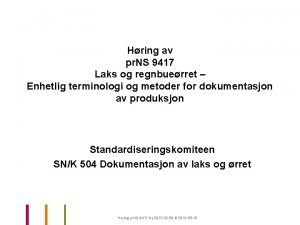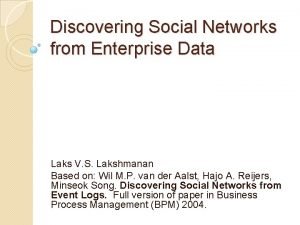The Generalized MDL Approach for Summarization Laks V
























- Slides: 24

The Generalized MDL Approach for Summarization Laks V. S. Lakshmanan (UBC) Raymond T. Ng (UBC) Christine X. Wang (UBC) Xiaodong Zhou (UBC) Theodore J. Johnson (AT&T Research) (Work supported by NSERC and NCE/IRIS. )

Overview • • Introduction Motivation & Problem Statement Spatial Case – MDL & GMDL Experiments X Categorical Case More Experiments X Related work Summary and Related/Future Work

Introduction • How best to convey large answer sets for queries? – Simple enumeration: accurate but not necessarily most useful – Summaries: not (necessarily) 100% accurate but can be more intuitive • Why is this problem interesting? – OLAP queries over multi-dimensional data typically produce data intensive answers

Introduction (contd. ) • Example: (i) customer segmentation based on buying pattern 10 frequency t salary K 9 • too many answers, 8 in general • solution: summarize • description via range constraints Þaxis-parallel hyper-rectangles Þmost concise = MDL 7 6 5 4 3 20 25 30 35 40 45 50 55 60 65 70 age

Introduction (contd. ) • Example: (ii) aggregate sales performance analysis clothes MW NE location NW vancouver edmonton san jose san francisco minneapolis chicago boston summit albany new york shorts dress pnts frml wear men’s jns blouses skirts wmn’s jns jkts tops • description via hierarchical ranges = tuples of nodes • most concise = MDL men’s women’s ties 2 * last year’s sales

Motivation • Examples: (i) customer segmentation based on salary K buying pattern 10 frequency t 9 X frequency < t/2 8 “white” otherwise white budget = 2 white budget 10 7 6 5 4 3 X X X 20 25 30 35 40 45 50 55 60 65 70 age

Motivation (contd. ) • Example: (ii) aggregate sales performance analysis clothes MW NE location NW vancouver edmonton san jose san francisco minneapolis chicago boston summit albany new york shorts dress pnts frml wear men’s jns blouses skirts wmn’s jns jkts tops • description via hierarchical ranges = tuples of nodes • most concise = MDL men’s women’s ties 2 * last year’s sales

Motivation (contd. ) • Example: (ii) aggregate sales performance analysis clothes MW NE location NW X white budget = 2 shorts dress pnts frml wear men’s jns blouses skirts wmn’s jns jkts tops X < ½ * last year’s sales vancouver edmonton san jose san francisco minneapolis chicago boston summit albany new york men’s women’s ties 2 * last year’s sales X X white budget 7

GMDL Problem Statement (spatial case) • k totally ordered dimensions Di S (set of all cells) • B (blue) and R (red) – colored cells • W = S – (B R) (white cells) • Find axis-parallel hyper-rectangles {R 1, …, Rm} (i. e. , GMDL covering) s. t. : – (R 1 … Rm) R = (validity) – |(R 1 … Rm) W| w (white budget) – m is the least possible (optimality)

(G)MDL Problem Statement (hierarchical case) • • k (tree) hierarchical dimensions cell = tuple of leaves region = tuple of nodes region R covers cell c iff c is a descendant of R, component-wise • covering rules similar to spatial case • MDL/GMDL problem formulations analogous

Algorithms for spatial GMDL • challenges for spatial: even MDL 2 D is NP-hard, so we must turn to heuristics • important properties: – blue-maximality – non-redundancy • Algorithms for spatial GMDL: – – bottom-up pairwise (BP) merging R-tree splitting (RTS) [based on Garcia+98] color-aware splitting (CAS) CAS corner

Algorithms for spatial GMDL (CAS) • build indices IR, IB for red and blue cells • start with C = region R covering all blue cells; curr -consum = # white cells in R • while ( R C containing a red cell) { – grow the red cell to a larger blue-free region (using IB) – split R into at most 2 k regions (excluding the grown red region) – replace R by new regions } • while (curr-consum > w) { – split as above, but based on white cells } • return C

CAS – An Example X X X trade-off • non-overlapping regions loss in quality • overlapping regions greater bookkeeping overhead • Algorithms RTS, the two CAS’ non-redundant valid/feasible solutions • BP may produce redundant solution; can be made non-redundant

Categorical Case – MDL • key diff. between spatial and categorical? • optimal covering non-redundant • optimal need not be blue-maximal, but can be expanded into one • is blue-maximal non-redundant MDL covering unique? what about their size?

A spatial example two blue-maximal non-redundant coverings of diff. size

Categorical – fundamentals • projection of regions on dimensions: e. g. , (MW, women’s) – projection on location = {chicago, minneapolis}. • Claim: R, S any categorical regions (tree hierarchies); Ri – projection of R on dimension i; i, Ri Si or Si Ri or R i Si = • see violation in “tough” spatial example • major factor in deciding complexity

Categorical – fundamentals (contd. ) • Theorem: space of k categorical dimensions with tree hierarchies unique bluemaximal non-redundant MDL covering. • Corollary: (i) the said covering can be obtained on a per hierarchy basis. (ii) furthermore, it can be done in polynomial time.

Categorical case – MDL algorithm illustrated i propagate ad 7 9 2 g a b h c e f after redundancy check before redundancy check acd c 2 abcdefghi i X ad X 5 6 initialize d 2 1 3 4 8 2 X 1 2 3 4 6 2 5 1 2 4 5 1 2 3 4 2 2 acd bc bc a a

Categorical case – MDL • Lemma: Optimal MDL covering for a categorical space with tree hierarchies can be obtained by visiting each node once and each node of last hierarchy twice. • Key idea: for tree hierarchies, finding all blue-maximal regions and removing redundant ones yields the optimal covering.

Categorical case – GMDL • Basic idea: for each internal node, determine the cost and gain of involving it in a GMDL covering; sort candidates in decreasing gain order and increasing cost. Pick greedily. • Example: candidate (1, h) occurrence 2 max-gain cost (2, h) (3, h) (4, h) (5, h) 4 1 2 1 1 3 0 1 0 2 0 3 X 3

Categorical Case – GMDL (contd. ) • Compile similar info. for other parents of leaves; sort and pick best w cells for color change. [drop candidates with cost X or 0. ] • Run MDL on the new data.

Related Work • Substantial work on using MDL for summarization principle in data compression [Ristad & Thomas 95], decision trees [Quinaln & Rivest 89, Mehta+ 95], learning of patterns [Kilpelinen 95], etc. • [Agrawal+ 98] – subspace clustering. • Summarizing cube query answers and (G)MDL on categorical spaces – novel.

Summary & Future Work • summarization using MDL/GMDL as a principle • MDL on spatial – NP-complete even on 2 D; utility of GMDL – trade compactness for quality (i. e. , include “impurity” in answers) • Heuristic algorithms • Efficient algo. for MDL for categorical with tree hierarchies • Heuristics for GMDL • Experimental validation

Future Work • What is the best we can do to summarize data with both spatial and categorical dimensions? • How far can we push the poly time complexity? (e. g. , almost-tree hierarchies? Can we impose restrictions on “allowable” intervals even on spatial dimensions? )
 Text summarization vietnamese
Text summarization vietnamese Abstractive summarization
Abstractive summarization Medical summaries for law firms
Medical summaries for law firms First law review
First law review Text summarization vietnamese
Text summarization vietnamese Entity summarization
Entity summarization Text summarization vietnamese
Text summarization vietnamese Laks tegning
Laks tegning Mdl lehrer neues dienstrecht
Mdl lehrer neues dienstrecht Haringsma mdl arts
Haringsma mdl arts Proyecto mdl
Proyecto mdl Jason laks
Jason laks Social searcher
Social searcher Microstation mdl programming tutorial pdf
Microstation mdl programming tutorial pdf Exemple projet mdl
Exemple projet mdl Dpp adalah
Dpp adalah Biomeditsiin
Biomeditsiin Gsi calendrier académique
Gsi calendrier académique Mdl information systems
Mdl information systems Mdl del grupo
Mdl del grupo Laks vs
Laks vs Laks v.s. lakshmanan
Laks v.s. lakshmanan Bad guys mdl
Bad guys mdl Myndigheten för delaktighet
Myndigheten för delaktighet Varians
Varians

